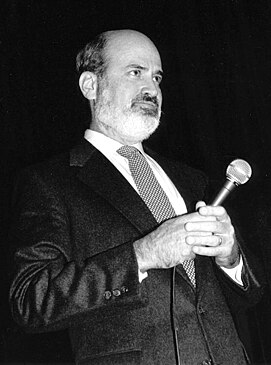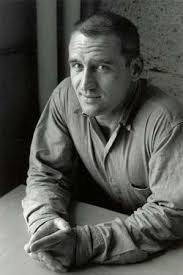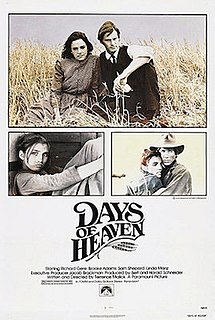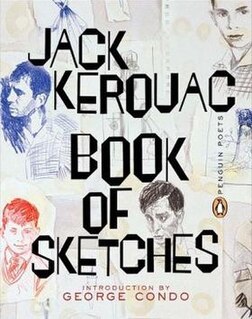
Jean-Louis Lebris de Kérouac, known as Jack Kerouac, was an American novelist and poet of French Canadian ancestry, who, alongside William S. Burroughs and Allen Ginsberg, was a pioneer of the Beat Generation.

Badlands is a 1973 American neo-noir period crime drama film written, produced and directed by Terrence Malick, in his directorial debut. The film stars Martin Sheen, Sissy Spacek, Warren Oates and Ramon Bieri. The story is fictional but is loosely based on the real-life murder spree of Charles Starkweather and his girlfriend, Caril Ann Fugate, in 1958. Like many of Malick's films, Badlands is notable for its lyrical photography and its music, which includes pieces by Carl Orff.

Terrence Frederick Malick is an American film director, screenwriter, and producer.

The Thin Red Line is a 1998 American epic war film written and directed by Terrence Malick. It is the second screen adaptation of the 1962 novel of the same name by James Jones, following the 1964 film; however, this film is not considered a remake. Telling a fictionalized version of the Battle of Mount Austen, which was part of the Guadalcanal Campaign in the Pacific Theater of World War II, it portrays soldiers of C Company, 1st Battalion, 27th Infantry Regiment, 25th Infantry Division, played by Sean Penn, Jim Caviezel, Nick Nolte, Elias Koteas and Ben Chaplin. The novel's title alludes to a line from Rudyard Kipling's poem "Tommy", from Barrack-Room Ballads, in which he calls British foot soldiers "the thin red line of heroes", referring to the stand of the 93rd Regiment in the Battle of Balaclava of the Crimean War.
The Beat Generation was a literary movement started by a group of authors whose work explored and influenced American culture and politics in the post-war era. The bulk of their work was published and popularized by Silent Generationers in the 1950s. The central elements of Beat culture are the rejection of standard narrative values, making a spiritual quest, the exploration of American and Eastern religions, the rejection of economic materialism, explicit portrayals of the human condition, experimentation with psychedelic drugs, and sexual liberation and exploration.

Neal Leon Cassady was a major figure of the Beat Generation of the 1950s and the psychedelic and counterculture movements of the 1960s.

On the Road is a 1957 novel by American writer Jack Kerouac, based on the travels of Kerouac and his friends across the United States. It is considered a defining work of the postwar Beat and Counterculture generations, with its protagonists living life against a backdrop of jazz, poetry, and drug use. The novel is a roman à clef, with many key figures of the Beat movement, such as William S. Burroughs, Allen Ginsberg, and Neal Cassady represented by characters in the book, including Kerouac himself as the narrator Sal Paradise.

Vanity of Duluoz: An Adventurous Education, 1935–46 is a 1968 semi-autobiographical novel by Jack Kerouac. The book describes the adventures of Kerouac's alter ego, Jack Duluoz, covering the period of his life between 1935 and 1946. The book includes reminiscences of the author's high school experiences in Lowell, Massachusetts, his education at Columbia University, and his subsequent naval service during World War II. It culminates with the beginnings of the beat movement. It was Kerouac's last work published during his life.

Days of Heaven is a 1978 American romantic period drama film written and directed by Terrence Malick and starring Richard Gere, Brooke Adams, Sam Shepard, and Linda Manz. Set in 1916, it tells the story of Bill and Abby, lovers who travel to the Texas Panhandle to harvest crops for a wealthy farmer. Bill persuades Abby to claim the fortune of the dying farmer by tricking him into a false marriage.

Bone Machine is the eleventh studio album by American singer and musician Tom Waits, released by Island Records on September 8, 1992. It won a Grammy Award for Best Alternative Music Album and features guest appearances by David Hidalgo, Les Claypool, Bryan Mantia, and Keith Richards. The album marked Waits' return to studio albums, coming five years after his previous effort Franks Wild Years (1987).

Janet Michelle "Jan" Kerouac was an American writer and the only child of beat generation author Jack Kerouac and Joan Haverty Kerouac.

Mexico City Blues is a poem published by Jack Kerouac in 1959 composed of 242 "choruses" or stanzas. Written between 1954 and 1957, the poem is the product of Kerouac's spontaneous prose, his Buddhism, and his disappointment at his failure to publish a novel between 1950's The Town and the City and 1957's On the Road.

Beat Generation is a play written by Jack Kerouac upon returning home to Florida after his seminal work On the Road had been published in 1957. Gerald Nicosia, a Kerouac biographer and family friend has said that theatre producer Leo Gavin suggested that Kerouac should write a play; the outcome being Beat Generation.

Book of Sketches is a collection of spontaneous prose poetry by the American novelist and poet Jack Kerouac, published posthumously in 2006. The poems, written in 1952 and 1953 in a notebook carried in his breast pocket, describe Kerouac's travels through the U.S. states of New York, North Carolina and Kansas, and the cities of San Francisco, California; Denver, Colorado; Mexico City, Mexico; and his birthplace of Lowell, Massachusetts. They also discuss themes of art, life, American, Buddhism, jazz, the role of the writer, loneliness and the wandering lifestyle. Book of Sketches features an introduction by the artist George Condo

Old Angel Midnight is a long narrative poem by American novelist and poet Jack Kerouac. It was culled from five notebooks spanning from 1956 to 1959, while Kerouac was fully absorbed by his studies of Buddhism and Buddhist philosophy. Kerouac initially experimented with Old Angel Midnight in 1953 in his diary titled "1953. Notes again." In entries dated from November 20 to December 3, 1953, he made notes on "Lucien Midnight" which was to be originally conceptualized in what he called "book movie" form, when he closed his eyes and projected onto paper a cinematic sense of what he heard. A bookmovie, he explained in Some of the Dharma, is a "prose concentration camera-eye visions of a definite movie of the mind with fade-ins, pans, close-ups, and fade-outs." Kerouac's notes on Lucien Midnight were written while staying in the Lower East Side where he initially heard sounds coming through a tenement window from the wash court below. He then heard voices coming from kitchens of the other occupants in nearby apartment buildings and a man named Paddy arriving home drunk, and even a junky stirring in his bed. Kerouac conceptualized an idea of developing a work based on James Joyce’s experimental novel Finnegans Wake where the “sounds of the universe” became the chief “plot” with all of its associated “neologisms, mental associations, puns and wordmixes” that stewed a plethora of languages and “nonlanguages.” Kerouac determinedly “scribbled out in a strictly intuitional discipline at breakneck speed” the fledgling prose that would finally comprise the finished book for City Lights's Pocket Poet series eight years later. Kerouac's one dogma was to compose Lucien Midnight strictly in pencil by candlelight. Lucien Midnight differs from his sketching method of writing because it is based upon an aural experience, and not visual. The bookmovie approach was abandoned in 1953 in favor of a different approach he had stylistically achieved by 1956.
A poetic journal is a literary genre combining aspects of poetry with the daily, or near daily, "takes" of journal writing. Born of twin impulses: to track change in daily life and to memorialize experience, poetic journals owe allegiances to Asian writing — particularly the Japanese haibun of Matsuo Bashō, The Pillow Book of Sei Shōnagon, and the poetic diaries of Masaoka Shiki — as well as Objectivist poets and others associated with Donald Allen's anthology The New American Poetry 1945-1960. Unlike traditional diaries or journals that focus primarily on recounting a day's experience, poetic journals emphasize the act of writing itself in collaboration with the day's account. Taking its cue from post-Jack Kerouac writers, like Bernadette Mayer and Clark Coolidge, the poetic journal aims to be all-inclusive as well as timely and attentive. To quote Tyler Doherty in his introduction to For the Time Being: The Bootstrap Book of Poetic Journals, "[The poetic journal] doesn't try to tell us what the world is, so much as remind us that the world is."

The Tree of Life is a 2011 American art film written and directed by Terrence Malick and featuring a cast of Brad Pitt, Sean Penn, Hunter McCracken, Laramie Eppler, Jessica Chastain, and Tye Sheridan in his debut feature film role. The film chronicles the origins and meaning of life by way of a middle-aged man's childhood memories of his family living in 1950s Texas, interspersed with imagery of the origins of the known universe and the inception of life on Earth.

Knight of Cups is a 2015 American drama film written and directed by Terrence Malick and produced by Nicolas Gonda, Sarah Green and Ken Kao. The film features an ensemble cast, starring Christian Bale as the central character.

The Beat Museum is located in San Francisco, California and is dedicated to preserving the memory and works of the Beat Generation.
Haldon Chase, often referred to as "Hal Chase", was a Denver-born archaeologist, who was known for his archaeological research on several rock art sites at Colorado. Outside the field of archaeology, he was best known as part of the earliest Beat circle.
















